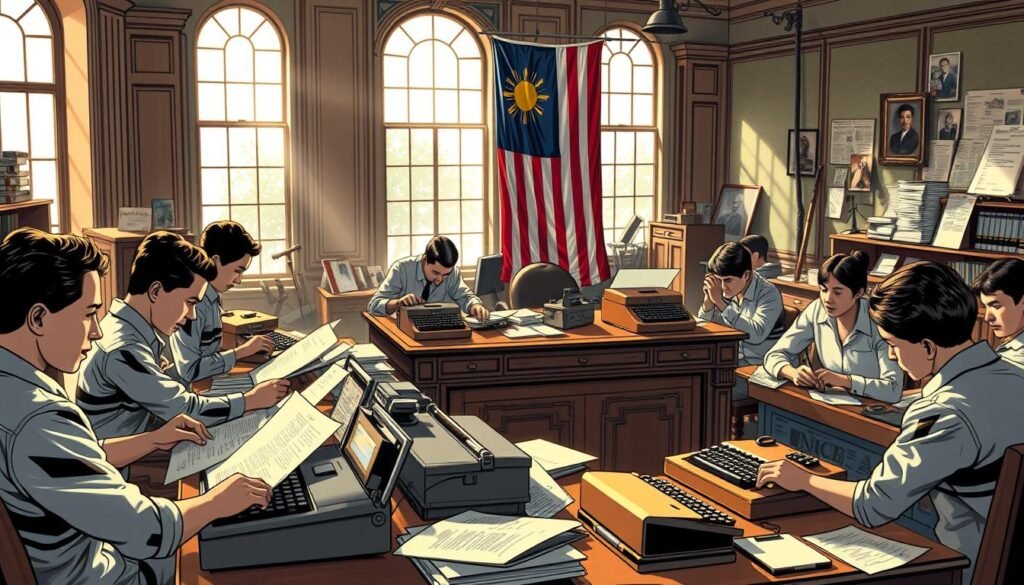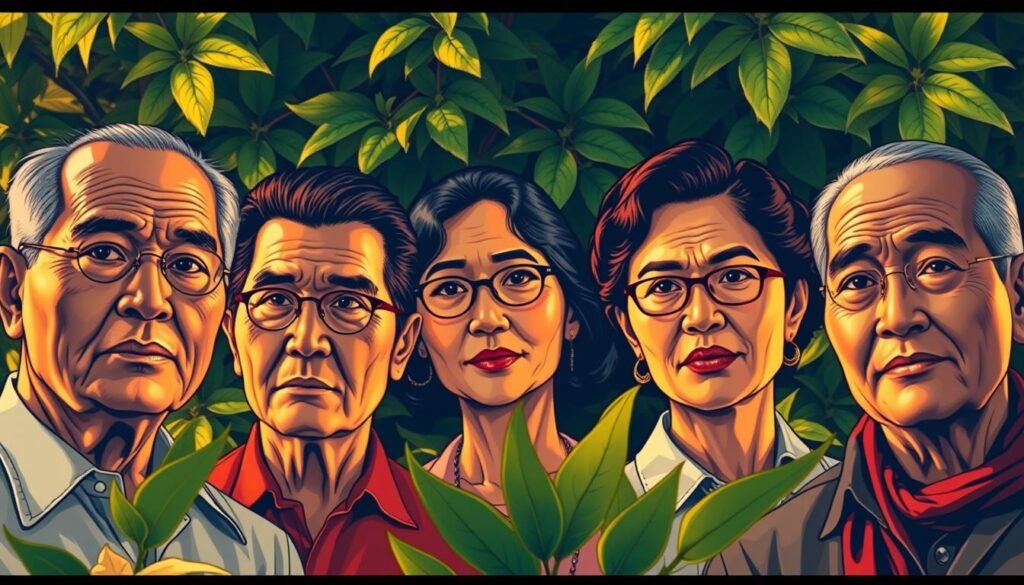Journalism in the Philippines has a rich history, deeply influenced by global trends and colonial legacies. During the American era, the media landscape underwent significant transformation. The introduction of English as the medium of instruction and the establishment of newspapers like The Manila Times and Manila Daily Bulletin marked a new chapter in Filipino journalism.
American educational models played a crucial role in shaping the skills of Filipino reporters. This period also saw the rise of radio broadcasting, which became a powerful tool for sharing news and stories across the country. From print to broadcast, the evolution of journalism reflects the Philippines’ adaptability to global media trends.
Today, the legacy of this era continues to influence the media landscape. The dedication of Filipino journalists to uncovering the truth and telling impactful stories remains a cornerstone of the nation’s identity.
Key Takeaways
- American colonial influences shaped Filipino journalism during the early 20th century.
- English became the primary medium of instruction, fostering a new generation of reporters.
- Radio broadcasting emerged as a key platform for news dissemination.
- The transition from print to broadcast media reflects global trends.
- Filipino journalists continue to play a vital role in shaping the nation’s media landscape.
Filipino Journalism in the American Era – A Historical Overview
The American era brought transformative changes to Filipino journalism, shaping its future trajectory. During this period, the media landscape evolved significantly, influenced by colonial policies and global trends. This section explores the key developments that defined journalism in the Philippines under American rule.
American Colonial Influences on Media
American colonial policies introduced new standards in media practices. Censorship became a tool to control public opinion, while editorial policies emphasized objectivity and accuracy. The establishment of English as the medium of instruction fostered a generation of skilled reporters.
Radio broadcasting emerged as a powerful platform, revolutionizing how news was shared. This marked a shift from traditional print media to modern broadcast journalism. The influence of American models is still evident in today’s media practices.
Rise of Local Press and Periodicals
The early 20th century saw the rise of local press and periodicals. These publications played a pivotal role in disseminating news and shaping public opinion. Editors became key figures, guiding the narrative and ensuring the credibility of their publications.
Daily newspapers gained prominence, reflecting the importance of timely reporting. The Manila Bulletin, founded in 1899, remains a testament to this era’s enduring legacy. Local press became a cornerstone of Filipino journalism, bridging the gap between the new and the traditional.

This period also highlighted the role of journalists in addressing societal issues. Their dedication to uncovering the truth laid the foundation for a robust media landscape. The transition from print to broadcast media mirrored global trends, positioning the Philippines as a key player in the world of journalism.
| Key Developments | Impact |
|---|---|
| Introduction of English | Fostered skilled reporters |
| Emergence of radio | Revolutionized news dissemination |
| Rise of local press | Shaped public opinion |
For a deeper understanding of colonial influences, explore this detailed analysis. The legacy of this era continues to inspire Filipino journalists, who remain committed to truth and integrity.
The Birth of a New Media Landscape in the Philippines
The media landscape in the Philippines underwent a dramatic transformation during the early 20th century. This period marked the beginning of a new era in communication, driven by the rise of print and broadcast media. These developments not only changed how news was shared but also shaped public opinion and societal norms.
Emergence of Print Media
Print media played a pivotal role in the early phases of the Philippines’ media evolution. Newspapers like The Manila Times and Manila Daily Bulletin became essential sources of information. They provided timely updates on local and global events, fostering a culture of informed citizenship.
The growth of print media also influenced societal structures. Editors and reporters became key figures, guiding public discourse and addressing critical issues. This era laid the foundation for a robust journalistic tradition in the country.

Advent of Broadcast Journalism
Broadcast journalism emerged as a powerful complement to print media. The introduction of radio revolutionized how news was disseminated, reaching audiences across the archipelago. Radio broadcasts became a daily ritual for many Filipinos, providing real-time updates and entertainment.
Universities also played a crucial role in this transformation. Journalism programs equipped aspiring reporters with modern techniques, ensuring the quality and credibility of news coverage. This shift from localized newspapers to broader media coverage mirrored global trends, positioning the Philippines as a key player in the world of journalism.
- Print media fostered a culture of informed citizenship.
- Radio broadcasts revolutionized news dissemination.
- University education enhanced reporting techniques.
- The shift from print to broadcast mirrored global trends.
Pioneering Faces in Filipino Journalism
The early 20th century witnessed the rise of Filipino pioneers who reshaped the media landscape. These trailblazers set high standards for integrity and independence, leaving a lasting impact on the world of journalism. Their contributions laid the foundation for the modern media practices we see today.

Trailblazing Editors and Reporters
Among the notable figures was Victorio A. Velasco, a writer and editor who founded The Filipino Forum in 1928. His work addressed labor disputes and discrimination, giving a voice to the marginalized. Velasco’s dedication to truth and justice inspired many aspiring reporters.
Another key figure was Teodoro M. Kalaw, who used his platform to advocate for Philippine independence. His editorials in El Renacimiento challenged colonial policies, earning him both admiration and controversy. These editors set a precedent for fearless reporting and editorial independence.
Influential Media Personalities
The American era also saw the rise of media personalities who shaped public opinion. Maria Ressa, a modern-day icon, continues this legacy with her work at Rappler. Her commitment to uncovering the truth has earned her global recognition, including the Nobel Peace Prize.
University training played a crucial role in shaping these innovative figures. Institutions like the University of the Philippines equipped aspiring journalists with the skills needed to navigate the evolving media landscape. This education ensured the quality and credibility of their work.
From Velasco to Ressa, these pioneers have demonstrated the power of journalism to drive social change. Their stories remind us of the importance of integrity and courage in the pursuit of truth.
The Role of Journalists in Social Change
Filipino journalists have long been at the forefront of driving societal transformation. Their work has not only informed the public but also challenged injustices and inspired movements for reform. From breaking news to in-depth investigations, they have played a pivotal role in shaping the nation’s progress.
One of the most significant contributions of journalism is its ability to act as a watchdog. Investigative reporters have exposed corruption, leading to legal actions and policy reforms. For example, their relentless coverage of political scandals has often resulted in public outcry and accountability.
Social movements have also been propelled by influential reporting. Coverage of human rights abuses and environmental issues has raised awareness and mobilized communities. A notable instance is the work of reporters during the #EndSARS movement, which amplified voices and spurred global attention.
Over time, the role of the reporter has evolved. Beyond just delivering facts, they now engage in public debate, offering analysis and context. This shift has made journalism a more dynamic force in shaping public opinion.
- Investigative pieces have challenged corruption and sparked reforms.
- Social justice reporting has fostered empathy and action.
- Opinion pieces and editorials have influenced policy changes.
- Quality journalism has improved societal standards.
As a writer, Maria Ressa has demonstrated the power of journalism to drive change. Her fearless reporting at Rappler has not only uncovered truths but also inspired a new generation of journalists. The legacy of these pioneers continues to remind us of the importance of integrity and courage in the pursuit of truth.
Innovative Journalists in the American Era
The American era introduced groundbreaking innovations in Filipino journalism, setting the stage for modern reporting techniques. This period saw journalists breaking traditional barriers and embracing new technologies to deliver accurate and impactful news.

Breaking Barriers in Reporting
During this time, reporters began to experiment with creative techniques to overcome political and cultural hurdles. Investigative journalism gained prominence, with figures like Bob Woodward leading the charge. His work on the Watergate scandal showcased the power of in-depth reporting in holding authority accountable.
New technologies also played a crucial role. The rise of radio and later television allowed journalists to reach wider audiences with real-time information. This shift from print to broadcast media marked a significant evolution in how stories were told and consumed.
Innovative formats, such as multimedia storytelling, emerged during this era. Journalists combined text, audio, and visuals to create engaging narratives. These methods not only enhanced the quality of reporting but also set a precedent for future media practices.
- Investigative journalism exposed corruption and sparked reforms.
- Radio and television expanded the reach of news dissemination.
- Multimedia storytelling enriched the narrative experience.
- Creative techniques overcame political and cultural challenges.
The impact of these innovations continues to shape the media landscape today. The dedication of journalists to pushing boundaries and embracing change remains a cornerstone of modern journalism.
Impact of American Education on Journalism Practices
American education played a pivotal role in shaping modern journalism practices in the Philippines. During the early 20th century, universities like the University of Missouri and Columbia University introduced advanced training programs that revolutionized reporting techniques. These institutions emphasized critical thinking, research, and ethical standards, which became the foundation of professional journalism.

University Training and Journalism Techniques
Journalism programs in American universities focused on both theoretical knowledge and practical skills. Courses in investigative reporting, multimedia storytelling, and data analysis equipped students with the tools needed to excel in the field. For example, the University of Missouri’s “Missouri Method” emphasized hands-on experience, allowing students to work in real newsrooms.
Academic research also played a significant role in advancing journalistic practices. Studies on media ethics, audience engagement, and the impact of television helped shape modern reporting standards. This research provided journalists with evidence-based strategies to deliver accurate and impactful news.
- American universities introduced advanced reporting techniques.
- Curriculum innovations included multimedia storytelling and data analysis.
- Academic research improved ethical standards and audience engagement.
- Hands-on training programs prepared students for real-world challenges.
Today, the influence of American education continues to benefit the journalism industry. The skills and methodologies developed in these programs remain essential for producing high-quality information and fostering public trust in the media.
Press Freedom and Challenges for Filipino Media
Press freedom in the Philippines faces significant challenges, with censorship and safety concerns at the forefront. The country ranks 134 out of 180 on the Press Freedom Index, highlighting ongoing struggles for media independence. External pressures, such as political interference and threats to safety, continue to hinder the work of journalists.

Censorship and Political Interference
Censorship remains a critical issue, with government policies often restricting the flow of information. During Rodrigo Duterte’s presidency, verbal attacks against journalists and judicial harassment of critical media were rampant. For example, the ABS-CBN network lost its franchise in 2020, leading to the closure of dozens of radio stations and TV channels.
Political interference also manifests through tactics like “red-tagging,” where journalists are labeled as threats to national security. This practice has created a chilling effect, discouraging reporters from covering sensitive topics. The National Union of Journalists of the Philippines (NUJP) has recorded 20 incidents of red-tagging under the current administration.
Ensuring Safety in Conflict Zones
Journalists in conflict zones face heightened risks, with many reporting threats or attacks. The 2009 Maguindanao massacre, where 32 reporters were killed, remains one of the deadliest events for journalists globally. Despite the establishment of the Presidential Task Force on Media Security in 2016, violence against journalists persists.
To ensure safety, many journalists adopt strategies like working in teams and using secure communication channels. However, these measures are often insufficient in high-risk areas. Freelance journalists, in particular, face additional challenges, such as difficulty obtaining press cards and securing stable contracts.
| Key Challenges | Impact |
|---|---|
| Censorship | Restricts information flow |
| Political Interference | Creates a chilling effect |
| Safety in Conflict Zones | Heightens risks for journalists |
These challenges not only affect the accuracy of news but also erode public trust in the media. The ongoing struggle to balance freedom and security remains a critical issue for Filipino journalists.
The Evolution of Reporting Techniques
From handwritten notes to digital platforms, reporting methods have transformed dramatically over the years. This evolution reflects the adaptability of journalism to technological advancements and societal changes. Traditional practices, once reliant on manual processes, have given way to modern techniques that prioritize speed and accuracy.

Adapting Traditional Methods
Historically, reporters relied on pen and paper, gathering news through interviews and field observations. The introduction of the printing press in the 15th century marked a significant leap, enabling mass production of newspapers. This shift allowed for more detailed and timely reporting, setting the stage for modern journalism.
In the 20th century, the advent of radio and television revolutionized news dissemination. Radio broadcasts provided real-time updates, while television added a visual dimension, enhancing audience engagement. These innovations not only expanded the reach of news but also introduced new storytelling formats.
Today, digital tools have further transformed reporting. Open-source platforms and social media enable instant updates, while AI and machine learning assist in data analysis. These advancements have improved accuracy and speed, allowing journalists to cover breaking stories in real-time.
| Historical Practices | Modern Techniques |
|---|---|
| Handwritten notes | Digital recording devices |
| Print newspapers | Online articles and blogs |
| Radio broadcasts | Live streaming and podcasts |
| Manual data analysis | AI-driven analytics |
Despite these changes, the core principles of journalism remain unchanged. Reporters continue to prioritize truth and integrity, adapting their methods to meet the demands of a rapidly evolving media landscape. As technology continues to advance, the resilience and adaptability of journalists will remain essential in shaping the future of news.
From Print to Digital: Transition in the News Industry
The digital age has revolutionized how we consume news, reshaping the media landscape globally. Over the past two decades, the shift from print to digital has fundamentally altered how information is created, distributed, and consumed. This transformation has been driven by technological advancements and changing reader preferences.

Digital Transformation of Newspapers
Print media, once the cornerstone of journalism, has seen a steady decline. The rise of the internet and mobile devices has made online platforms the primary source of news for millions. According to recent data, over 5.35 billion people worldwide now use the internet, creating a vast audience for digital content.
One of the key triggers behind this shift is the convenience of digital platforms. Readers can access news anytime, anywhere, without the need for physical newspapers. Additionally, the COVID-19 pandemic accelerated this trend, with print supplies plummeting to almost zero during lockdowns.
Online platforms have also redefined the distribution of news. Social media, in particular, has become a critical tool for content promotion and audience engagement. Journalists now use these platforms to share breaking news and interact with their audience in real-time.
Benefits and Challenges of the Digital Shift
The transition to digital has brought both opportunities and challenges. For journalists, digital tools like AI and machine learning have improved accuracy and speed in reporting. Multimedia elements such as videos and infographics have enhanced storytelling, making content more engaging.
However, this shift has also posed challenges. Online readers have shorter attention spans, requiring journalists to adapt their writing styles. Clear, concise, and catchy headlines are now essential to attract clicks. Additionally, the rise of subscription-based models has forced traditional print media to rethink their revenue strategies.
| Aspect | Print Media | Digital Media |
|---|---|---|
| Distribution | Physical newspapers | Online platforms |
| Cost | Higher production costs | Lower advertising costs |
| Audience Reach | Limited by geography | Global reach |
For a deeper understanding of this transition, explore this detailed analysis. The digital transformation of the news industry continues to evolve, reshaping traditional media landscapes and setting new standards for journalism.
Influential Editorials and Opinion Pieces in the American Era
The American era marked a turning point in editorial writing, with influential pieces shaping public discourse. These writings not only informed readers but also sparked debates on critical social and political issues. From major newspapers to emerging magazines, editorials became a cornerstone of journalism.
One of the most notable examples was the coverage of the Spanish-American war. Newspapers like The New York Journal and The New York World used sensational headlines to sway public opinion. Their editorials played a significant role in building support for the conflict, showcasing the power of the press.

Key correspondents also emerged during this time, leaving a lasting impact. Figures like Richard Harding Davis reported from the frontlines, blending factual reporting with compelling narratives. Their work not only informed but also humanized the realities of war, influencing public sentiment.
Editorials in publications like The Atlantic and Harper’s Magazine addressed broader societal issues. They tackled topics like labor rights, women’s suffrage, and racial equality. These pieces often combined rigorous research with persuasive arguments, setting a standard for modern opinion writing.
- Editorials shaped public opinion on critical issues like the Spanish-American war.
- Correspondents like Richard Harding Davis brought frontline stories to life.
- Magazines addressed societal issues, blending research with persuasive writing.
- The stylistic elements of these pieces set benchmarks for modern journalism.
The legacy of these editorials continues to inspire today’s journalists. Their commitment to truth and their ability to drive change remain foundational to the field. For more on the impact of investigative reporting, explore this detailed analysis.
From the Spanish-American war to social reforms, editorials of the American era proved the enduring power of the written word. Their influence on public discourse and journalism practices remains unparalleled.
Journalism Ethics and Standards in the Modern Age
Ethics in journalism have become a cornerstone of modern reporting, ensuring trust and credibility in the digital age. As the media landscape evolves, maintaining objectivity and adhering to ethical standards is more critical than ever. This section explores the evolution of journalism ethics, the role of editorial standards, and the measures taken to enforce objectivity.
Maintaining Objectivity in Reporting
The foundation of ethical journalism lies in objectivity. Reporters must present facts without bias, ensuring their work serves the public interest. Editorial standards and codes of conduct play a vital role in maintaining credibility. For example, organizations like The New York Times enforce strict guidelines to prevent conflicts of interest and ensure impartiality.
Biased reporting can erode public trust and harm democratic discourse. Case studies, such as the coverage of the 2016 U.S. presidential election, highlight the challenges of maintaining objectivity in polarized environments. Journalists must navigate these complexities while upholding ethical principles.
Continual training in ethical journalism is essential. Workshops and courses help reporters stay updated on best practices and emerging challenges. This ongoing education ensures that journalists remain committed to truth and integrity.
| Ethical Principle | Description |
|---|---|
| Accuracy | Ensuring all information is verified and correct. |
| Fairness | Presenting all sides of a story without bias. |
| Independence | Avoiding conflicts of interest. |
| Accountability | Taking responsibility for errors and correcting them promptly. |
For a deeper understanding of the importance of ethics in journalism, explore this detailed analysis. The commitment to ethical standards remains a defining feature of quality journalism, shaping the future of the industry.
The Role of Television and Radio in Filipino Journalism
The rise of television and radio in the Philippines marked a new era in how news was delivered and consumed. These platforms brought stories to life, reaching audiences in ways print journalism could not. From the early days of radio broadcasts to the dominance of television, broadcast media reshaped Filipino journalism.
Radio emerged as a powerful tool in the mid-20th century, providing real-time updates and entertainment. Programs like DZRH became household names, offering a mix of news, music, and public service announcements. This medium bridged the gap between urban and rural areas, ensuring everyone had access to information.
Television took this a step further, combining visuals with audio to create a more immersive experience. Networks like ABS-CBN and GMA became leaders in broadcast journalism. Their flagship programs, such as TV Patrol, set the standard for news reporting in the country.
During critical historical events, broadcast media played a pivotal role. The coverage of the EDSA People Power Revolution in 1986 showcased the power of television and radio in mobilizing the public. These platforms provided real-time updates, helping shape the narrative of the movement.
Compared to print journalism, broadcast media offered immediacy and accessibility. While newspapers required physical distribution, radio and television reached audiences instantly. This broadened the reach of Filipino journalists, allowing them to connect with millions.
Today, the relevance of television and radio continues. Despite the rise of digital platforms, these traditional media remain trusted sources of news. Their ability to adapt to changing times ensures they remain integral to the Filipino media landscape.
Celebrating Notable Journalists and Correspondents
The world of journalism has been shaped by remarkable individuals whose stories and contributions continue to inspire generations. From groundbreaking investigations to heartfelt storytelling, these professionals have left an indelible mark on the field. This section celebrates their achievements and the innovative ways they’ve transformed the media landscape.
Profiles of Award-Winning Journalists
One such figure is Maria Ressa, a modern-day icon in journalism. Her work at Rappler has earned her global recognition, including the Nobel Peace Prize. Ressa’s dedication to uncovering the truth in the face of adversity serves as a beacon for aspiring reporters.
Another notable journalist is Richard Harwood, whose career spanned decades and multiple publications. Known for his dual role as an editor and teacher, Harwood guided countless journalists, leaving a lasting legacy in the industry.
These individuals remind us of the power of perseverance and integrity in journalism. Their stories inspire us to strive for excellence and uphold the principles of truth and accountability.
Innovative Reporting Stories
Innovation has always been at the heart of impactful journalism. The Tampa Bay Times’ investigative reporting on workplace safety led to new measures protecting workers and residents. This is a prime example of how journalism can drive tangible change.
Another groundbreaking story came from The Miami Herald, which covered the Champlain Towers South condominium collapse. Their blend of compassionate storytelling and accountability set a new standard for reporting on tragedies.
These stories highlight the evolving role of journalists in society. By embracing new techniques and technologies, they continue to push the boundaries of what’s possible in the field.
- Maria Ressa’s fearless reporting at Rappler earned her the Nobel Peace Prize.
- Richard Harwood’s mentorship shaped the careers of many journalists.
- The Tampa Bay Times’ investigations improved workplace safety standards.
- The Miami Herald’s coverage of the Champlain Towers collapse set new benchmarks in reporting.
From award-winning profiles to innovative reporting, these journalists have redefined the news industry. Their work serves as a testament to the enduring power of journalism in shaping society.
Legacy of Filipino Journalists in the Global Arena
Filipino journalists have carved a unique space in the global media landscape, influencing international reporting. Their work has not only shaped local narratives but also addressed pressing global issues, earning them recognition on the world stage.
One notable example is Maria Ressa, whose investigative reporting at Rappler has brought attention to global disinformation campaigns. Her dedication to truth has inspired journalists worldwide, showcasing the power of Filipino storytelling in the digital age.
Collaborations with foreign media have further amplified their impact. Filipino reporters have partnered with international outlets like The New York Times and BBC, covering stories from climate change to human rights. These partnerships highlight their ability to adapt and thrive in diverse media environments.
Their unique perspectives, rooted in the Philippines’ rich cultural and historical context, set them apart. This blend of local insight and global relevance has made their work indispensable in addressing complex international issues.
Influential works, such as Ressa’s How to Stand Up to a Dictator, have become essential reading for aspiring journalists. These books not only document their experiences but also offer valuable lessons on resilience and integrity in journalism.
Filipino journalists continue to contribute to global journalism standards, advocating for ethical reporting and press freedom. Their legacy serves as a reminder of the enduring power of truth in shaping a better world. For more on their role in combating misinformation, explore this study.
Reflections on Journalism and Media Innovation
The evolution of journalism has always been a reflection of societal changes and technological advancements. From the early days of print to the digital age, each era has left its mark on how we gather and share information. The American era, in particular, introduced practices that continue to shape modern media.
Lessons from Historical Shifts
During the American era, journalists adapted to new tools and platforms, setting the stage for today’s innovations. The introduction of radio and television revolutionized how news was delivered, emphasizing the importance of speed and accessibility. These historical shifts remind us that adaptability is key to staying relevant in a rapidly changing field.
Education has also played a crucial role in driving media innovation. Universities have equipped aspiring reporters with the skills needed to navigate modern challenges. Programs focused on digital storytelling and data analysis ensure that the next generation of journalists is prepared for the future.
Traditional practices, such as investigative reporting, have evolved with new technologies. Tools like AI and machine learning now assist in uncovering stories that were once impossible to find. This blend of old and new highlights the enduring value of core journalistic principles.
One transformative moment was the rise of the book as a medium for in-depth storytelling. Works like Maria Ressa’s How to Stand Up to a Dictator demonstrate the power of long-form journalism in addressing complex issues. Such examples remind us that innovation doesn’t mean abandoning tradition but building upon it.
As we look to the future, the lessons from the American era remain relevant. Embracing change while preserving integrity ensures that journalism continues to serve its purpose. For more insights on the importance of media literacy, explore this detailed analysis.
The journey of journalism is a testament to its resilience. By learning from the past and embracing the future, we can ensure that the field remains a cornerstone of democracy and truth.
Conclusion
The journey of Filipino journalism reflects a blend of tradition and innovation, shaping its global impact. From the early days of print to the digital age, the field has evolved significantly, driven by technological advancements and educational influences. The university system played a pivotal role in equipping journalists with the skills needed to navigate these changes.
Filipino journalists have made remarkable contributions, both locally and internationally. Their work has not only informed but also inspired, setting high standards for ethical reporting. The rise of digital platforms has further expanded their reach, allowing for more diverse and inclusive storytelling.
As we look to the future, the legacy of Filipino journalism serves as a reminder of the importance of adaptability and integrity. The book of history continues to be written, with each chapter reflecting the resilience and creativity of those who tell our stories. For more insights on the future of journalism, explore this detailed analysis.
FAQ
How did American colonial influences shape Filipino journalism?
American colonial rule introduced Western media practices, including freedom of the press and modern journalism techniques, which laid the foundation for the local press in the Philippines.
Who were some pioneering Filipino journalists during the American era?
Notable figures include editors and reporters like Teodoro M. Kalaw and Rafael Palma, who championed press freedom and social reform through their work.
What role did journalists play in social change in the Philippines?
Journalists used their platforms to advocate for independence, expose injustices, and promote democratic ideals, significantly influencing public opinion and policy.
How did American education impact journalism practices in the Philippines?
American universities introduced formal journalism training, equipping Filipino writers with skills in investigative reporting, editorial writing, and ethical standards.
What challenges did Filipino journalists face during the American era?
They dealt with censorship, political interference, and safety risks, especially when reporting on sensitive issues or in conflict zones.
How did the transition from print to digital media affect Filipino journalism?
The shift to digital platforms expanded reach and accessibility but also required journalists to adapt to new storytelling formats and technologies.
What is the legacy of Filipino journalists in the global arena?
Filipino journalists have gained international recognition for their resilience, innovation, and commitment to truth, inspiring media professionals worldwide.
How did television and radio influence Filipino journalism?
These mediums revolutionized news dissemination, making information more accessible and engaging for a broader audience while shaping public discourse.
What lessons can be learned from the historical shifts in Filipino journalism?
The evolution of journalism highlights the importance of adaptability, ethical reporting, and the enduring power of media to drive societal change.
Source Links
- The Print Media: A Tradition of Freedom – National Commission for Culture and the Arts
- Media Museum
- The history of Philippine media
- The Philippines: Amid troubles, a rich press tradition – Committee to Protect Journalists
- I. Philippine Media During the American Occupation – A Historical Background
- History
- Philippines
- Philippines
- Victorio Velasco: Pioneer of Filipino-American Journalism
- ‘Life of journalists is cheap’ – how the Philippines became deadly for reporters
- Unleashing the Power of Journalism for Social Change
- Social Media Journalism and Its Impact on Social Change: The Case of Twitter(X)
- Top 12 Most Influential Journalists Of Today
- The 100 Outstanding Journalists in the United States in the Last 100 Years: Nominees – NYU Journalism
- No title found
- The social group influences of US health journalists and their impact on the newsmaking process
- In the Philippines, some progress for media rights, but risks remain
- Philippines
- Philippines: journalists under attack despite government commitments
- Where Journalists Find Experts | Rolli
- History of journalism
- The Evolution of Reporting in the Digital Age: A Look at Online News Media • Journalism University
- Navigating the Print to Digital Transition in Media
- How can you transition from print to digital journalism?
- Milestones in the History of U.S. Foreign Relations
- Journalism’s Essential Value | The New York Times Company
- Public opinion – Mass Media, Social Media, Influence | Britannica
- No title found
- Global Media Ethics
- Philippines
- Journalists as Politicians: The Power of the Broadcast Media in the Philippines | Transnational Institute
- Mass media in the Philippines
- Celebrating Pulitzer-Winning Journalists | Werth
- Celebrating a Journalist’s Life – Nieman Reports
- Microsoft Word – Philippines. FOE study.doc
- Press Freedom in the Philippines
- World Press Freedom Day: Reflections on the State of Journalism by Emma Schoppmeyer, Civil Society Unit Intern | United Nations
- Why journalism is a great foundation for media innovation, content strategy and more
- Conclusion: On the Establishment of Journalistic Authority
- Conclusion and recommendations | Declining media freedom and biased reporting on foreign actors in Serbia

